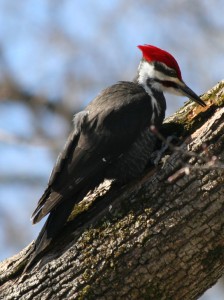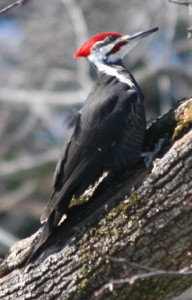Northern Flicker
The Northern Flicker (Colaptes auratus,) is a widespread and common species that can be spotted foraging along the ground for insects in your backyard or in woodlands across much of North America. Like all woodpeckers, they are often heard before they are spotted, capable of producing loud drumming on wood or metal. Their striking coloration sets them apart from other woodpecker species, flashing brilliant yellow or red highlights depending on geographic location. While Northern Flickers are widespread and listed as Least Concern on the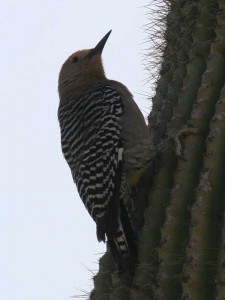 IUCN Red List, populations across much of their geographic range have been experiencing declining numbers.
IUCN Red List, populations across much of their geographic range have been experiencing declining numbers.
Description: The Northern Flicker is a large species of woodpecker, easily distinguished by their white rumps, black-scalloped plumage, and striking black chests. They reach a mature size of 11” to 12” in length, and 4oz. to 6oz. in weight with a 16.5” to 20” wingspan and 4.5” to 5” long flared tail (which tapers to a point1.) They have slender, round heads and 1.5” long bills that curve slightly downward. Their barbed tongues are used to capture insects, reaching a length of 2” when thrust out of their bills.
The Northern Flicker is the only woodpeckers to have white rumps and gray-brown barred backs marked with black scallops. Their undersides are pale buff to white with black spotting and their chests feature black crescents. Northern Flicker males have tan heads, gray faces, red or black moustaches, gray crowns and red or black napes and are generally more colorful than females2. Geographic color variations occur. The flight feathers, underwings and beneath the tail are highlighted with bright yellow (in eastern populations) or salmon-red (in western populations.)
Northern Flickers in eastern regions are referred to as ‘Yellow-Shafted,’ known for the bright yellow coloration that appears on the flight feathers, underwings, and below the tail. They also have red napes and black moustache stripes. Western populations, known as ‘Red-Shafted,’ have salmon-red coloration on flight feathers, underwings, and below their tails. They lack the red nape found in other populations, have red moustaches, paler undersides and broader crescents on their breasts. In the Great Plains region on the edges of eastern and western habitats, hybrids can occur. These individuals typically have a combination of the characteristics of eastern and western populations
Northern Flickers are one of the only North American woodpecker species that is migratory. Northern populations move to southern portions of their geographic range between September and October and return to their northern habitats between March and April. Some populations have been observed migrating to Cuba, the Grand Cayman Islands, or as far south as Nicaragua.
Northern Flickers prefer to forage on the ground but may also be found climbing tree trunks or perched upright along horizontal branches. In flight, they use an undulating flight pattern, alternating heavy wing flaps with periods of gliding to create a bouncy, slow flight3.
Male Northern Flickers can be quite aggressive, especially in the defense of a mate or territory. Displays of aggression can include “bill poking,” which consists of pointing and pecking their bills in the direction of an opponent, “head swinging, and “head bobbing.” Aggression may also be communicated through fanned out tails4.
In addition to body posture, Northern Flickers communicate with a variety of sounds. Their calls include a piercing rattle, which has an undulating volume and lasts for around 8 seconds. This call is made by individuals establishing mating pairs and territories and can be heard in the spring and early summer. Another sound consists of a single, piercing note (which lasts half a second) that is made year round called a kyeer. Interacting Northern Flickers often make a soft, slow wicka-wicka sound. Most often associated with woodpeckers is the loud, rhythmic drumming they produce by hammering on wood, or metal. This drumming is used as a means of communication and defense. Northern Flickers are capable of 25 evenly spaced beats per second, often interspersed with long series of wick-wick-wick sounds5. You may also hear the incessant calls of young Northern Flickers in the late summer.
Northern Flickers have been known to live to over 9 years old but in the wild most Northern Flickers survive only a few years.
Habitat: Northern Flickers can be found in woodlands, flooded swamps, along forest edges or marsh edges, in city parks, suburban backyards and birdbaths, open fields amongst scattered trees, and in western mountain ranges in all stages of forest (as high up as the tree line.)
Within their habitats, Northern Flickers are vulnerable to birds of prey, including Cooper’s Hawks. Raccoons, snakes, and squirrels prey on their young. However, when approached by a predator, Northern Flickers show little response. They may fly tentatively around the predator or thrust their bill in the direction of the threat6.
Location: The geographic range of the Northern Flicker stretches across much of North America, from Alaska to Quebec and south across the entire United States. As a migratory species, some populations of Northern Flickers migrate to southern areas of their geographic range or as far south as the Grand Cayman Islands, Cuba, and the highlands of Nicuargua7.
Diet: Northern Flickers are omnivorous and are often found chiseling into the ground in search of insects. Like other woodpeckers, Northern Flickers also chisel into wooden surfaces for boring insects. First, a Northern Flicker will tap on a surface to listen for insect activity within. After chiseling a hole with their curved bill (in the ground or in wood) they insert their 2” long barbed tongue to snare their meal. Their diets consist mainly of ants, beetles, and beetle larvae. They also consume fruit (including wild cherries, grapes, elderberries, hackberries, and bayberries,) seeds, nuts, flies, moths, butterflies, caterpillars, aphids, wasps, termites, crickets, grasshoppers, snails, and a variety of vegetation (including poison ivy, oak and sumac, Virginia Creeper, Dogwood, and Hackberry.) During the fall and winter their diets consist mainly of fruit.
Reproduction: Northern Flickers tend to breed once annually during their breeding season, which occurs between February and July (although these birds have been known to breed twice within one breeding season.) Individuals return to the same breeding area year after year.
Beginning in the early spring, male Northern Flickers participate in rival displays to attract potential mates. These shows, called “fencing duels,” are preformed in front of females and may include head bobbing (in males use their raised bills to draw figure-eight patterns in the air,) and wicka sounds.
After mating pairs have been formed, both males and females begin excavating a nest. These nests are often built in cavities in trees (sometimes within a nest formerly used by those birds or other birds,) within ground burrows (previously built by other bird species such as Belted Kingfishers,) in old utility or fence posts, or within house siding. Northern Flickers are unlike other woodpecker species in their tendency to reuse their nesting cavities from previous breeding seasons or cavities made by other species8. Nests are excavated to a depth of 13” to 16” and lined with woodchips, widened at the bottom to accommodate eggs and incubation. Nests have entrances that are 3” in diameter and are generally 6’ to 15’ off the ground, although occasionally nests are built substantially higher9.
Between 3 to 12 glossy white eggs (measuring .7” to 1.5” in length) are laid and incubated by both parents for 11 to 13 days. The chicks are born (using their egg teeth to break through their shells,) pink, naked, and clumsy with closed eyes. Both parents feed the chicks even after they have fledged. The chicks begin clinging to the nest walls by 17 days old and begin following their parents out to forage before they are ready to leave the nest at 24 to 27 days old (or by mid-July10.) The chicks molt and develop their adult coloration between June and October. Sexual maturity is reached by one year of age.
Notes of Interest: Northern Flickers are protected under the Federal Migratory Bird Treaty Act.
Footnotes
1. http://www.allaboutbirds.org/guide/northern_flicker/id
2. http://animaldiversity.ummz.umich.edu/accounts/Colaptes_auratus/
3. http://www.allaboutbirds.org/guide/northern_flicker/id
4. http://animaldiversity.ummz.umich.edu/accounts/Colaptes_auratus/
5. http://animals.nationalgeographic.com/animals/birding/northern-flicker/
6. http://animaldiversity.ummz.umich.edu/accounts/Colaptes_auratus/
7. http://animaldiversity.ummz.umich.edu/accounts/Colaptes_auratus/
8. http://www.allaboutbirds.org/guide/northern_flicker/id
9. http://www.allaboutbirds.org/guide/northern_flicker/id
10. http://wdfw.wa.gov/living/woodpeckers.html
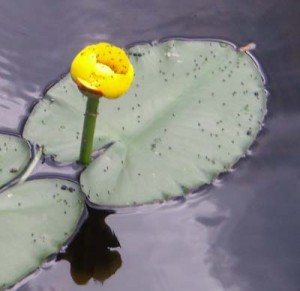
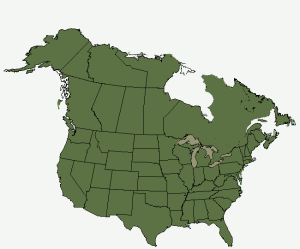 Notes of Interest:
Notes of Interest: